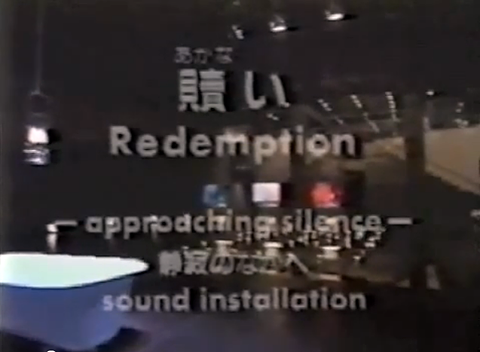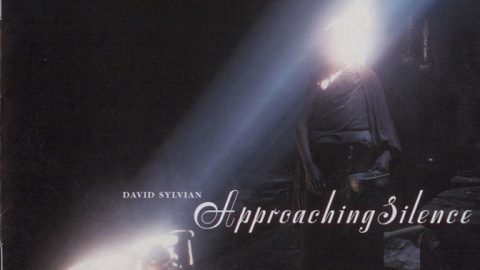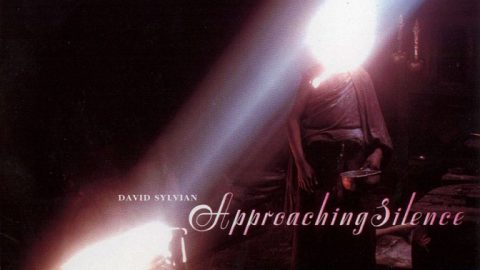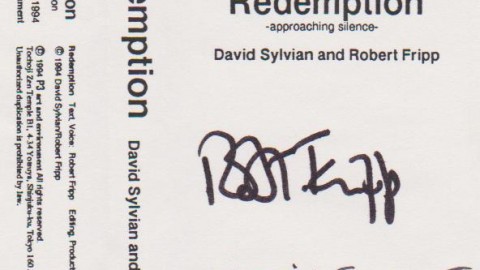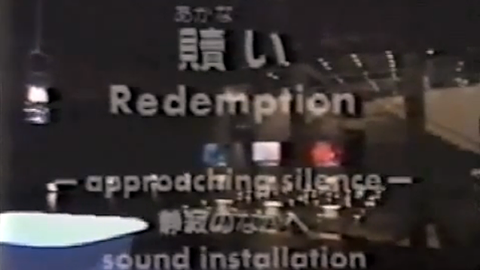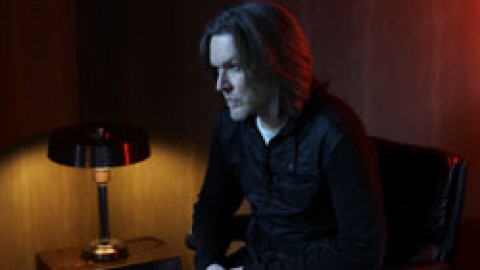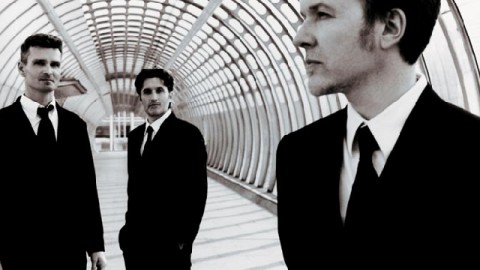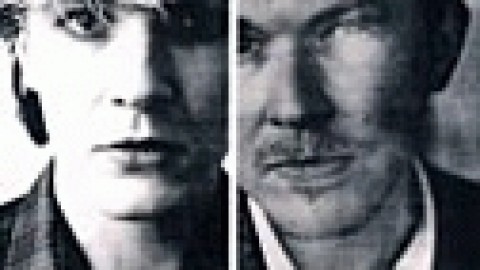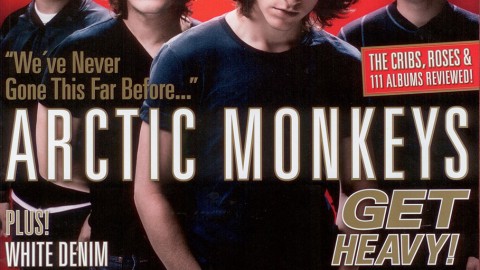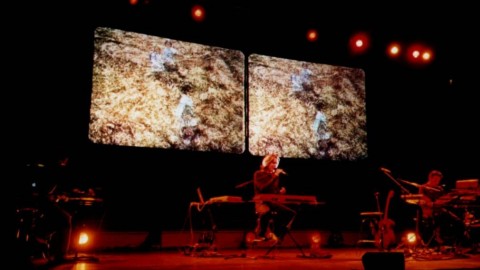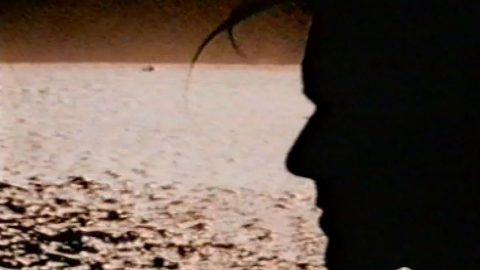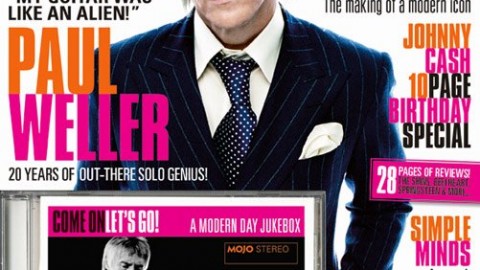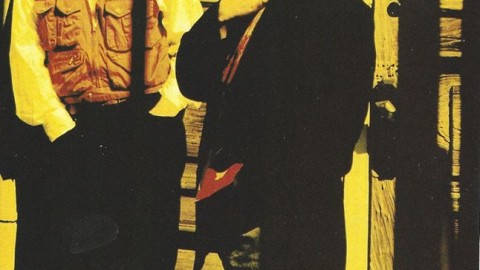by Craig Peacock
The following interview took place in October 1994 at the P-3 Gallery near Shinjuku, one of Tokyo’s many shopping and business centres. The gallery itself is located in the basement of a temple. This is not as spiritual as one would expect, as it’s surrounded by ugly office and residential buildings. The clatter of modern life in Tokyo attacks one from all sides.
The installation Sylvian and Fripp were presenting was titled Redemption. In stark contrast to the concert tour just one year earlier, the work received scant attention in the foreign press and only a little more in the Japanese.
The installation itself consisted of a large room lined by floor-mounted monitors displaying a foetal-like face in tones of beige and red. The centre of the floor was covered in mirrors, atop which candles flickered in an artificial breeze. Three chairs conveyed the candles as they hosted skulls and graphic panels, while behind stood a bathtub illuminated by a hanging lantern. A passage led to another room, small and dark, where under a red glow a monitor displayed Robert Fripp’s text as hidden speakers played a cut-up recording of his recitation.
The music was ghostly and enveloping, the barrage of an orchestra sweeping over you at ever-increasing intervals.
Sylvian was dressed in a swish black Issey Miyake t-shirt and black pants. He looked happy and healthy, not the gaunt figure of the past who smoked a stream of Gauloises. This is the conversation verbatim.
Having seen Ember Glance in 1990, it appears that in comparison this time you are trying to exercise greater control over the environment the observer experiences.
I found Ember Glance to be somewhat cluttered. I would’ve simplified it. I could have just worked with the final area of Ember Glance, the partitioned wall. I think it would’ve been enough in that space. When I was asked to work on this installation I wanted to keep it fairly simple. As you say, be more in control of the composition itself. As in working with music, one needs to pull the right elements together, make sure they are the right elements and discard all that’s unnecessary.
CP: What role has Haruki Kaito played in this installation?
DS: Haruki Kaito has done the lighting for it. Adam Lowe, an English artist, came up with the artwork.
“Certainly.”
CP: Robert (Fripp) has contributed the text for the installation. The text pursues the concept of redemption as ‘the buying back of humanity’. How well do you think you’ve added a visual medium to this concept?
DS: It’s a matter of creating an experience in which the potential lies to open up to that possibility to some degree. It’s a massive thing to undertake when working on such small scale. It’s the same with the redemptive powers in music and poetry. You put material out there, potential exists in the work and you hope that somebody that may stumble across that and find within in it some catalyst to a greater experience. To bring the listener or the observer to a place where they’re comfortable with silence so that it doesn’t scare them and the depth of that silence and all that it embodies isn’t too overwhelming, that there is a stillness one can just take a look at for a while. If we can get that far, it would be amazing. From that point onwards the work can take care of itself. Once you know you can’t go back from knowing, you can’t deny it and you take on a greater responsibility. I call it ‘voluntary responsibility’. One can’t just walk through life blindly, you must take responsibility for every action.
CP: This has been a long-running theme for you. You’ve often spoke of your work as a catalyst for the listener to discover something within themselves or others.
DS: Absolutely.
CP: The subtitle of this work is Approaching Silence. Based on the few minutes I’ve spent observing the installation and the people observing it, I would say that you’ve achieved your aim. Everyone in there looks so peaceful.
DS: Thank you.
CP: The music for the installation is impressive and at times overwhelming. How did the music develop, I understand Holger Czukay was involved in some way?
DS: Actually I was working on some material for my wife Ingrid Chavez’s album, and I asked Holger to send me over a batch of random samples of material that I could use on her album and amongst those he sent was this one, which is the predominant sample that you hear, a kind of orchestral barrage. As soon as I heard that, I thought that it would be my starting point. I built the composition around that using a series of other samples from a variety of sources.
CP: The music for this installation is far more developed and less spontaneous than that used for ‘Ember Glance’.
DS: Yeah, I would say so. It’s more controlled, as the piece develops over a period of 40 minutes, the appearance of the orchestral barrage sample becomes more and more sporadic, so there’s a feeling of slowing down and the dynamic diminishes.
CP: I noticed that many of the people in there were actually sitting down and spending time to take it all in.
DS: That’s interesting, I wasn’t expecting that. It’s nice to know. I expected people to whiz around and then out, and I don’t think that’s bad, people have a limited amount of time to spend. Hopefully they should still be able to take something away.
CP: Moving on to the live album coming out soon (Damage). Robert seems extremely happy with it, saying they caught you on a very good night. Is it true that Robert is very much a live person and you are far more a studio person?
DS: For sure. Although I really enjoyed the last tour. That’s due to my relationship with Robert. I felt more at ease, not only on stage but also in my life. I’m also getting older and feeling more comfortable standing in front of an audience. In comparison In Praise of Shamans was a mess, I was a mess at the time. The whole entourage was beset with problems.
CP: It was a large band.
DS: Yeah, I’m not sure I chose all the right musicians, but it wasn’t so much the band as behind the scenes that was chaotic. We never really got to grips with the material. We took it so far in rehearsal and it was meant to develop further on the road and open up more. But it began to drift and there was no grounding to it because I wasn’t able to concentrate enough to take it to the next stage. It wasn’t a happy family of musicians.
I’d virtually given up the idea of playing live after that until going out with Robert and the trio. There was no pressure in that at all, it was total pleasure.
The concert that was recorded for this album was in London, very relaxed but dynamic. I think we got a good recording. As Robert handed the production to me on The First Day I handed the reins to him on this album because as you said it is more his territory than mine.
CP: I had the good fortune to see the three-piece (Sylvian, Fripp & Gunn) in Osaka in early 1992. I remember reading at the time that you thought that show was the best of the tour.
DS: Possibly, I have no recollection now.
CP: It was in a Japanese-language magazine.
DS: I see (laughs).
CP: I missed the atmosphere of the three-piece, there was something personal about the keyboard/guitar/stick format.
DS: There was an intimacy with the trio.
CP: There were some stunning ballads performed at that time as well. Will we ever get to hear those again?
DS: Um, it’s unlikely. We have The First Day on the live album, and also Damage (note: Damage was not performed on the trio tour). Robert just said he’d like to do the trio again, probably as a result of talking about it with you (laughs). When we did the trio we had a week each to write and rehearse, and we went with what came up. Obviously some things work and others don’t. The ones that didn’t work were dropped from the repertoire.
CP: The short rehearsal period didn’t show, the sound was very tight.
DS: Oh, really?
CP: I have a bootleg of that show – not a great recording – but I’m very fond of it. Maybe I should hang on to it?
DS: Certainly (laughs).
CP: Robert mentioned that you are now working on Ingrid’s album. Will the sound be very different from her last album?
DS: I like her last album, but she was unhappy with it because she couldn’t get a lot of her ideas on it, it was very much controlled by Prince. She was in a band prior to that, and they put out a local tape which is closer to where she is musically. The spoken word is still an important part of what she’s doing and the music is still very soulful. I guess there is a greater emphasis on texture and atmosphere.
CP: Your influence?
DS: Yes, but it’s also where her heart lies. Obviously my influence will be there, but we view it as a partnership anyway. I have a compilation album coming out next year and hopefully Ingrid’s album will have found an outlet by that time. I’d like to tour them together.
CP: Your role is very much co-composer and producer?
DS: Yes.
CP: Will your compilation be one of your solo work?
DS: Yes, solo and collaborative. It pulls together all of the different things I?ve done over the last 10 years or so. It will save people fishing for this or that track I did with Sakamoto and such.
CP: Why don’t you do a bonus CD of rarities? There are some wonderful tracks like Blue of Noon that should not be lost to vinyl forever.
DS: Yeah, I’d like to get Virgin to agree to add on a rarities CD for the first whatever number of copies and of course Blue of Noon would be on that. I like that track too.
CP: That was from the Brilliant Trees sessions?
DS: That’s right. That was my stab at jazz at the time. I had a second stab at it on what become Wave on Gone to Earth. I have this other session of that track with John Taylor on piano, Steve (Jansen) on drums and Ian Maidman on bass… I wonder if I can salvage anything from that? It is kind of nice and in the same vein as Blue of Noon.
CP: Wave was given an interesting arrangement performed live on the last tour.
DS: Wave was a great disappointment to me on record. I wanted to have another bash at it I think we got a little closer this time.
CP: River Man also gained a new dimension.
DS: Yeah, I agree. For me both tracks on record failed in the rhythm section. As I said earlier Wave started out more like a ballad with a jazz feel but it didn’t work. We started to play with different rhythms and settled on the one you hear but it never satisfied me, it was too rigid and very hard to work with. It did have totally different melody and lyrics at one point, which all of the musicians had played along with . I did change it though and Robert for one was very pissed at that (laughs).
CP: Will you do another solo album in the future?
DS: I will do it at the end of 1995. I know that sounds a long way off but I’m building a studio at home and I want to be settled before I start.
CP: You are living in Minneapolis now. How is life there?
DS: It’s very good for me now. I’m not sure we’ll stay there for a number of years but it’s quiet and it’s a good base to return to. I feel cut off from a lot there and that’s what I need right now. Prior to meeting Ingrid, living in London I was losing it, I was very mixed up. I needed to get away from the memories. Too many difficult relationships came to an end, including the band members of Japan (Karn, Jansen and Barbieri). The whole thing was very painful. Now my life is simple, the way I like it.
CP: I understand. You mentioned the other members of Japan. Have you heard their post Rain Tree Crow work?
DS: I heard a large chunk of Mick’s album and some of the things Steve and Rich have done. I thought Mick’s album (Bestial Cluster) was the best thing he’s ever done. That was nice to see. During the RTC recordings the times I heard Mick and Steve on the point of giving up… It’s nice to know that Mick came back with that positivity.
CP: Back in 1984 you guested as DJ on Sakamoto’s Sound Street on FM Tokyo. The songs you played at the time were by Joni Mitchell, Scott Walker, Bill Evans and Robert Wyatt. What has impressed you in the 10 years since then?
DS: I could probably say the same names as those you’ve mentioned (laughs). The evergreens who’ve always been there for me along with Nick Drake and Tom Waits and so on. I listen to so much, I’m an avid record buyer, but not so much is connecting with me right now. I like John Taverner, just for the space, so I can breathe in the music. I find less in jazz these days. Pop music….hmmm, I love what Michael Brook has just done with Nusrat Fateh Ali Khan, it’s a beautiful record.
CP: Robert spoke about his recent collaborations with The Grid and The Future Sound of London, both of whom remixed Darshan for you. Were you happy with the remixes?
DS: The FSOL didnt really remix, they reconstructed (laughs)!
CP: As they tend to do!
DS: I thought they did a great job. I wasn’t so impressed with The Grid’s work, but it was fairly innocuous. It’s difficult to hand over a piece to a remixer, you have to have faith in them. I just felt Darshan lent itself to that. I think the FSOL had a whale of a time doing it.
CP: They both shortened it which was odd.
DS: I expected it to be elongated (laughs)
CP: Indeed, I thought the FSOL would get it up to 60 minutes! They are interested though, and work in a similar way to The Aphex Twin on remixes.
DS: Yeah, I can’t imagine getting much out of doing it myself even though I’ve been asked.
CP: I think they do it in order to eat..
DS: Probably true! (laughs) I like what the Aphex Twin does and I like the FSOL, they’re the best examples of modern electronic music that is going somewhere.
CP: Speaking of good new music have you heard Jeff Buckley’s album? It’s one of my favourites at the moment.
DS: No I haven’t. I was thinking about buying it as I’d read a piece about him and he came across very well. I’m glad you mentioned that, I’ll buy it!
CP: Going back to the live album, Russell Mills and Shinro Ohtake have done the artwork. How do work with artists such as Russell and Shinro, and also graphic designers such as Vaughan Oliver?
DS: My closest working relationship is with Russell. But now because of distance the communication isn’t there. I’m keen to establish a community of artists in Minneapolis to work with. I’ve found a very good designer working there called Scott Makela. He and I will be working together on the compilation and other things (Note: Makela designed the ‘Slow Fire’ tour programme). With Vaughan we only communicate by fax, but I like his work and I trust him to do good work.
CP: How about Akira Nakajima, whose work you?ve commented on?
DS: He sent me some pictures some years back, mostly the nudes which I found attractive. Later he sent me the abstract compositions which I thought were beautiful.
CP: Have you seen a video of the live broadcast of the Graceland tour?
DS: Oh, yes. I haven’t sat through all of it though, no way… unbearable (laughs). The sound mix… I wish Seigen (Ono) would’ve worked a little harder on some of the pieces… the drums were really loud! (laughs) It’s the same with listening back to performances, I can’t do it but Robert and Trey (Gunn) do all the time.
CP: Was Trey involved in the music for the installation?
DS: No, originally we planned that he would be but the budget didn’t work out.
CP: Trey’s solo record is a personal favourite of mine.
DS: It’s a great record. He’s one of those musicians you can ask anything of and it’s there, no matter how abstract the request. The way he handles the Stick, he’s an incredible player and a very sweet guy.
CP: Well, thank you very much for your time.
DS: Thank you, it was nice talking with you.
1994 by Craig Peacock. (This interview was published previously on weatherbox.com and re-published with kind permission of Craig Peacock)

